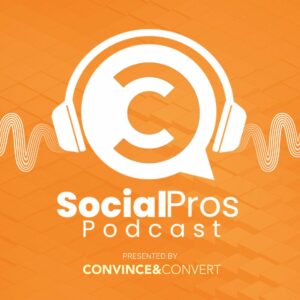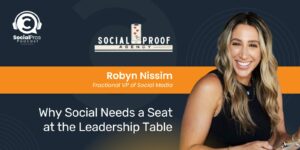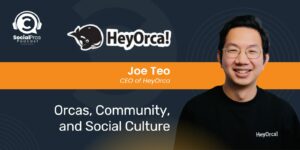Hosted By
About Social Pros Podcast:
Social Pros is one of the longest-running marketing podcasts in existence (10 YEARS and counting), and was recently recognized as the #1 Audio/Podcast Series by the Content Marketing Awards.
Our purpose? Making sure that we speak to real people doing real work in social media.
Listeners get inside stories and behind-the-scenes secrets about how teams at companies like Google, Reddit, Glossier, Zillow, Lyft, Marvel, and dozens more, staff, operate, and measure their social media programs. With 600+ episodes, the Social Pros Podcast brings the humanity of social media to the forefront, while providing incredibly useful marketing strategies that listeners can immediately implement.
Follow Social Pros on LinkedIn.
To inquire about becoming a guest or show sponsor, please email our Executive Producer, Leanna Pham, at leanna@convinceandconvert.com.
Apple Podcast Reviews:
The Social Pros podcast has quickly become a favorite in my feed! I'm consistently impressed by the engaging conversations, insightful content, and actionable ideas. I truly learn something every time I listen!
@Arlie KThis is absolutely an awesome listen for anyone in communications or social media!!
@Will31CThis podcast has become one of my staple weekly podcasts for learning about marketing! Love the conversations that they have and it's always enjoyable and educational!
@Simonstone95Love the podcast - informative, in depth and spot on for any business size.
@MissTriathlon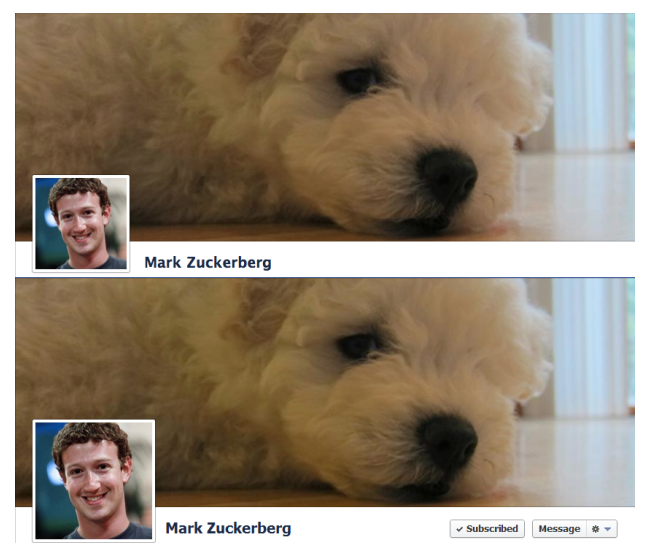
This is Episode 12 of the Social Pros Podcast : Real People Doing Real Work in Social Media. This episode features Derek Halpern founder of Social Triggers. Read on for insights from Derek, and Eric’s Social Media Stat of the Week (this week: for Facebook advertising, CPM rates are up 41%, CPC rates are up […]
 This is Episode 12 of the Social Pros Podcast : Real People Doing Real Work in Social Media. This episode features Derek Halpern founder of Social Triggers. Read on for insights from Derek, and Eric’s Social Media Stat of the Week (this week: for Facebook advertising, CPM rates are up 41%, CPC rates are up 23%).
This is Episode 12 of the Social Pros Podcast : Real People Doing Real Work in Social Media. This episode features Derek Halpern founder of Social Triggers. Read on for insights from Derek, and Eric’s Social Media Stat of the Week (this week: for Facebook advertising, CPM rates are up 41%, CPC rates are up 23%).
Listen Now
Click the play button to listen here:
[podcast]http://socialpros.podbean.com/mf/web/5emrm/SocialProsEpisode12.mp3[/podcast]
Download the audio file:
http://socialpros.podbean.com/mf/web/5emrm/SocialProsEpisode12.mp3
The RSS feed is: http://feeds.feedburner.com/socialprospodcast
Find us on iTunes: http://itunes.apple.com/us/podcast/convince-convert-blog-social/id499844469
Please Support Our Sponsors
Huge thanks to data-driven social media management software company Argyle Social for their presenting sponsorship, as well as Infusionsoft and Jim Kukral at DigitalBookLaunch. We use Argyle Social for our social engagement; we use Infusionsoft for our email; and Jim is our guest host for the podcast and a smart guy).
Social Pros Transcript For Your Reading Enjoyment, Thanks to Speechpad for the Transcription
![]()
Jay: And we are back with episode number 12 of Social Pros. I am Jay Baer, as always, accompanied, by my trusty virtual sidekick Eric Boggs. Eric, how are you sir?
Eric: Doing just fine, Jay. Happy for number 12.
Jay: I shouldn’t say you’re a virtual sidekick, just that you’re not here in the same location as I am. You are an actual sidekick, but just located virtually.
Eric: Exactly.
Jay: We’re in the cloud, baby.
Eric: Yeah, you could say that.
Jay: Really quick, I want to thank our sponsors, Eric’s fine company Argyle Social, who we use for all of our social media happenings. Also our good friends at Infusionsoft, which we use for all of our email happenings. And our good friend Jim Kukral from digitalbooklaunch.com, super-smart guy. He’s actually going to be filling in week after next. I will be at a conference and he’s going to be pinch hitting, as host of this fine program.
Eric: That’s a good reminder. I need to track down guests. I’ll ping Jim via email and we’ll get somebody good.
Jay’s Thought of the Week
 Jay: Fantastic. So, been an interesting week in the interwebs, I tell you what. There’s a lot of crazy stuff going on. Last week we talked of course about the big Instagram deal. This week there’s been a lot of little sticking and moving kind of stuff. Google+ made their profile pictures bigger. Oh, and guess what, a couple days later Facebook made their profile pictures bigger.
Jay: Fantastic. So, been an interesting week in the interwebs, I tell you what. There’s a lot of crazy stuff going on. Last week we talked of course about the big Instagram deal. This week there’s been a lot of little sticking and moving kind of stuff. Google+ made their profile pictures bigger. Oh, and guess what, a couple days later Facebook made their profile pictures bigger.
Eric: Funny how that works.
Jay’s Thought of the Week
Jay: It’s crazy. As if the extra 20 pixels is going to be the big difference between usage and non-usage. But it is pretty funny how all this is becoming a game of mimicry. I wanted to talk about something else as my message of the week. Our friend Jeremiah Owyang, from Altimeter Group published a really interesting blog post over the weekend, about the trend of social media agencies getting deep into social media advertising. Facebook advertising, Twitter advertising, LinkedIn advertising, etc.
He was on a road show in New York City recently, and met with a number of the mid-sized, and wanting to be larger social agencies in the city. And found that invariably they were getting really serious about social media advertising. It’s a really great post, we’ll make sure we link it up. Excellent comments. To me though, I really think that’s a short term play for the social media agency guys. To me if you look at the mechanics of Facebook ads, Twitter ads, LinkedIn ads, even YouTube ads, the way those ads are bought and trafficked and targeted is fundamentally similar to the way Google AdWords works. In fact it’s highly similar.
For me over the medium term, it seems like the large SEO SEM firms are going to be the ones who can make a legitimate claim to the social advertising budget. Because they have the long term optimization and math experience to do it well. When social advertising becomes more about numbers and less about experimenting with an experimental budget, I think the guys who have been spending millions and millions and millions of dollars on this for years are going to come in and take that budget away. I understand it, right? These social agencies want to get big and they want to get bought. The reality is there’s going to be a handful of social agencies that get bought out at a ten to 12 times multiple, by SEO agencies, or by large multi-national advertising holding companies. The rest are going to end up being $5 or $10 million a year lifestyle businesses, which ain’t all bad, but it’s not the same outcome. I think this is an 18 month play for social media advertising, for the social agency community. And then it’s going to be game over. Mr. Boggs, what do you think?
Eric: I think that you hit the nail on the head when you talk about this in terms of who has experience managing multi-million dollar ad budgets. When Facebook rolled out their ad platform, in such a way that it became very obviously a lot like Twitter’s ad platform, where it was all about promoting organic content, Adam my business partner at Argyle and I hopped on the phone with Jim Tobin a couple days later. He was actually at that conference. Jim is the president of Ignite Social Media. We basically had a very similar conversation about the upcoming battle between social agencies and traditional paid media agencies. The consensus really was that look, this is really about managing a huge chunk of money and less about optimizing individual posts for likes and comments and things like that. I tend to agree that the people that are managing the big ad budgets today are going to continue to manage the big ad budgets tomorrow. They’re just going to be spending a little bit more of it on Facebook and Twitter and everywhere else.
Jay: Yeah, because it’s a different skillset. Saying “look, we’re going to do your community management, we’re going to do your social listening, we’re going to do your monitoring. We’re going to do some high value KPI reports. We’re going to tweet on your behalf.”
A friend of mine who used to work for VaynerMedia which is one of the companies that Jeremiah talked to for his blog post, his job was to tweet the Cap’n Crunch account. He was Cap’n Crunch on Twitter and Facebook. If your job is to charge a brand tens of thousands of dollars a month to tweet from Cap’n Crunch (note: we don’t know what they were paid), that’s not the same skillset as managing a $10-$15 million a year Facebook ad budget. It’s just not.
Eric: Yeah. What’s going to be really interesting is I think there will be a long term place for social agencies, and there obviously will be a long term place for big media agencies. The silos between the two will be curious. We work with a ton of agency customers, and I’ve been in this business for a while now. It boggles my mind how the social agency can’t do some things because some other agency has access to Google Analytics, or some other agency does the email. That to me is going to be the big issue for all the players in this game. What is a problem is only going to become a bigger problem, because now there’s going to be big money funneling into social and there’s an additional party in the conversation, and that’s the social agency.
Jay: Absolutely. You have I think a related social media stat of the week.
Eric’s Social Media Stat of the Week: CPM Rates are Up 41%, CPC Rates are Up 23%, and Ad Engagement is Down
Eric: I do, I do.
Jay: That’s going to be my new sounder, I’m going to do that. ‘Social media stat of the week.’ I’m going to do that.
Eric: I hope you do it exactly like that every time.
Jay: We don’t even need to actually record it because I can do it on command.”Social media stat of the week.”
Eric: Yeah, this actually dovetails nicely. You would think that we actually plan these things.
Jay: I tell you what, it’s amazing.
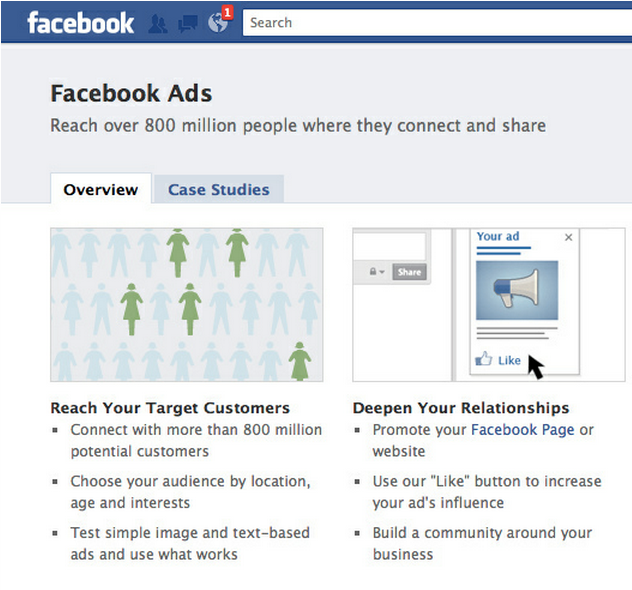 Eric: We actually found this this morning, doing our daily plotting around the Internet. A group called TBG Digital, which is a big time seller of Facebook ad campaigns, they manage big Facebook ad budgets for big clients. They released a lot of data from the past three months, and they’re basing their findings on 327 billion ad impressions from 235 advertising clients. They basically have aggregated some of their client data. It’s all anonymous of course, and reported some cost and performance information. It’s really fascinating stuff and I don’t think any of it is terribly surprising. One over the past three months. CPM rates are up 41%. This is the theme, everything is getting more expensive. All these data points are cut by geography. The U.S. and the UK have seen the biggest increases over the past three months.
Eric: We actually found this this morning, doing our daily plotting around the Internet. A group called TBG Digital, which is a big time seller of Facebook ad campaigns, they manage big Facebook ad budgets for big clients. They released a lot of data from the past three months, and they’re basing their findings on 327 billion ad impressions from 235 advertising clients. They basically have aggregated some of their client data. It’s all anonymous of course, and reported some cost and performance information. It’s really fascinating stuff and I don’t think any of it is terribly surprising. One over the past three months. CPM rates are up 41%. This is the theme, everything is getting more expensive. All these data points are cut by geography. The U.S. and the UK have seen the biggest increases over the past three months.
Two, CPC rates are up 23%. The other side of that is that ad engagement is down. When you look at the ad engagement graphs, and we’ll link up to this report in the blog post of the podcast, the changes are fairly small. What you’re seeing is this supply demand issue of the Facebook user base has plateaued or is growing at a decelerating rate, but the site is becoming more and more attractive for advertisers. There are more and more advertisers, a lot of new advertisers actually, clamoring for less ad inventory. Facebook recently rolled out more inventory, so all those things are driving up cost and driving down engagement and performance.
Jay: You said it exactly right, it’s supply and demand. The same thing happened with Google ads. I remember quite clearly back in the day when I was just a young boy, buying ads on Google. Before that Yahoo!, and before that Overture and Go To, back in the way back days. When you could literally get keywords and clicks at $0.10 a click. You could have whole swaths of your campaign that were $0.10 a click. Those days went the way of the dinosaur, as soon as everybody rushes in and says, “Oh, an efficient way to buy advertising. Let’s do that.” It doesn’t surprise me, although 41% in a quarter is a pretty steep ramp.
Eric: Oh yeah. We saw the same thing with LinkedIn ads at Argyle. When we first started advertising on LinkedIn, we were blown away by how cheap it was. It’s more than tripled. This is over a period of maybe 12 months.
Jay: That’s why it’s so important when you’re putting together metrics for your campaigns. You have to measure downstream behavior, that builds your business, not just clicks. It might be worth it. 41%, you might still be killing it, but you will never know that if you’re only measuring clicks. You have to measure the behaviors that those clicks generate, whether it’s leads or sales or something else in your funnel. Because otherwise you say,
“Geez, we’re playing 41% more for clicks or for CPM,” or 22% more per clicks I think you said the stat was. You may say, “It’s not worth it,” but it’s totally worth it. But you don’t know unless you’re measuring the right things.
Eric: Yeah, exactly. Exactly. I just wonder how quickly the bidding will accelerate. Are we going to see another 41% over the next three months, or is this going to level out? To me that’s what’s going to be fascinating.
These clients for TBG are big business. I think the long tail local ad market on Facebook will probably be much, much more reasonably priced for the long term, but we’ll see.
Jay: Yeah, it’s a really interesting time. I feel like we’ve seen this movie before. It’s a sequel that had ten years between movies. It really does feel like the early days of SEM and PPC search.
Eric: Yep.
Special Guest: Derek Halpern of Social Triggers
Jay: Somebody who knows an awful lot about getting people to click on stuff, whether it’s an ad or otherwise, is our special guest this week on the Social Pros podcast. Mr. Derek Halpern from Social Triggers, one of the finest and most interesting blogs out there on this great web of ours. Derek, thank you for being a guest. How are you my man?

Derek: Hey man, what’s up? Thanks for having me.
Jay: It is our pleasure. Now, you were originally a psychology major, right? You actually have a degree in psychology, thus it is actually appropriate that you have a blog and a consulting practice, etc., that focuses people on getting people to behave in a particular way online. As opposed to most people who fake all this stuff, you actually have a background in it. How do you define a social trigger?
Derek: Let me just clarify one thing. I studied psychology in college, but the real studying happened after college. It wasn’t really what I learned in school, it’s what I learned after school. I spent a lot of time reading academic papers or books that talk about persuasion, psychology and science. I guess I don’t have a major in psychology, but I’ve given myself a major after the fact.
Jay: Nice.
Eric: I believe they call that the “school of hard knocks.”
Jay: Yes. Exactly.
 Derek: Yeah. A social trigger, quite simply, is a little button that when you press it, it gets people to take some form of action. Any kind of action, whether you want people to share your content, subscribe to your email list, buy your products, click your ads, anything. Social trigger is a little button that you can activate and convince people to click that button, to influence some behavior down the line.
Derek: Yeah. A social trigger, quite simply, is a little button that when you press it, it gets people to take some form of action. Any kind of action, whether you want people to share your content, subscribe to your email list, buy your products, click your ads, anything. Social trigger is a little button that you can activate and convince people to click that button, to influence some behavior down the line.
Jay: Not necessarily an actual button. It could be something that triggers them emotionally. You don’t necessarily mean a button you necessarily press.
Derek: Yeah, there’s actually three types of buttons you could press. There’s an emotional button, there’s a logic button, and then the last button is a sense of duty and respect to whoever you are and what you stand for.
Eric: Can you talk about…
Jay: Cool. Which one would be the podcast? I think the listening to the podcast is duty, right? That’s what that one is?
Eric: Exactly.
Derek: Yeah, no. I actually got this from Nancy Duarte‘s book “Resonate.” She actually talked about how there’s the emotional buttons, logical buttons and then ethical buttons. Each button has its own place, but in general you want to be able to push all three of them, especially when you’re trying to sell products. The more buttons you push at any one time, the more results you’ll have for whatever it is you’re trying to promote or sell.
Jay: What’s the most important factor then, in getting those social triggers to be pulled? Is it the quality and the type of content, or is it the call to action itself?
Derek: That is actually a very good question.
Jay: Thanks. I should do this for a living.
Derek: The call to action is vitally important. That’s one of the things that most people mess up on. I see people buying advertisements on TV and finally, it took Facebook to create Facebook pages for big companies to finally include a call to action in their ads. It’s to like them on Facebook which, it’s not “buy my stuff” or anything like that but it’s a call to action, thank God. Call to action is vitally important, but before you even get to the call to action you’ve got to make sure you’re hitting the right emotional triggers and logical triggers in your target customer. You don’t want to just tell people, “Hey, buy my stuff.” They’re not going to buy your stuff unless you set up the sale. Call to action’s important to have, but you’ve got to make sure you set up the call to action the right way.
Eric: Can you walk us through an example? I totally get what you’re talking about, but I think it would be very helpful to paint a picture of a customer that you work with or something that you built on your site, that walks us through the acquisition funnel where you touch people at different places in their psyche as you move them down this path.
 Derek: All right. Let’s break this down. Let’s talk about Social Triggers. Social Triggers mainly targets people who want to increase the conversion rates of their website, right? I wrote an article, and in this article I started off very calmly. I was like, “If you leave your web design up to your web designer, you’re an idiot.” Now, this is pushing the emotional button because most people hire web designers so they can create the web design. This is a little contrary to what they think web designers should do. Why does that make someone an idiot? Well, first things first, if you leave it up to your web designer they don’t know anything about conversions. They’re going to give you a pretty picture, not a business building design. I’m giving you this quick example because this is the opening where one of the social triggers is creating an enemy of some kind. You want to position yourself or your content against some enemy. What I did there was positioning myself against web designers who don’t know anything about conversions. That was great for bringing in the people who want to increase their conversion rates for my audience.
Derek: All right. Let’s break this down. Let’s talk about Social Triggers. Social Triggers mainly targets people who want to increase the conversion rates of their website, right? I wrote an article, and in this article I started off very calmly. I was like, “If you leave your web design up to your web designer, you’re an idiot.” Now, this is pushing the emotional button because most people hire web designers so they can create the web design. This is a little contrary to what they think web designers should do. Why does that make someone an idiot? Well, first things first, if you leave it up to your web designer they don’t know anything about conversions. They’re going to give you a pretty picture, not a business building design. I’m giving you this quick example because this is the opening where one of the social triggers is creating an enemy of some kind. You want to position yourself or your content against some enemy. What I did there was positioning myself against web designers who don’t know anything about conversions. That was great for bringing in the people who want to increase their conversion rates for my audience.
As another good example, something that more people would be able to connect with, is just think about the “I’m an Apple, I’m a PC” commercial. What’s that all about? That’s all about positioning as this cool, hip brand against the dreaded PC who a bunch of nerds use. Nerds use PCs. That’s an example of a common enemy trigger. That’s a great way to start off the campaign, to get attention, create the enemy. As you proceed through that campaign after you create the enemy, you essentially set up the call to action before you ask for it. In such a way that gets people to think to themselves, if I don’t convert, I’m obviously siding with the enemy and I don’t want to do that. That’s what the “I’m a PC and I’m a Mac” commercial does. It basically says Macs are cool, PCs are for nerds. If you don’t own a Mac you must be a nerd and uncool.
Eric: That’s like this thing I used to do with my little brother. I would just swing my fists in the air and say, “I’m just going to walk toward you and if you don’t move I’m going to punch you.” It is a little bit of this thing of it’s a clever psychological manipulation. I think it’s very cool how purposeful you are, in how you think about this kind of stuff.
Derek: Yeah. I guess I’m weird like that. I think about everything. Even now when I write certain sentences I think, this is going to hit this psych trigger. Do I want to hit that trigger yet or wait? And I usually move stuff around based on a sentence by sentence basis.
Eric: I totally get it. That’s awesome.
Jay: Would you say then that people should spend more time on their content, or more time promoting that content?
Derek: It’s actually really funny that you’re asking me that question. Because I just conducted a little survey over the last maybe week or so. I asked bloggers especially or businesses, when they’re creating their blog, how much time do you spend creating your content versus promoting your content? I found that most people said that about 80% of the time they spend on creation, 20% on promotion. That’s the stupidest thing you can do. If you spend all this time creating content and not promoting it, how are you going to make sure people even know your content exists? Especially for businesses who are just trying to start building their presence. If you spend all this time on creation, no one is going to see what you’ve created unless you promote it. In the beginning, you’re better off spending 80% of your time promoting the content you create, the 20% of the content that you create.
Jay: Yeah, I would have to agree with that. I think that’s absolutely true, especially for new companies. This whole “we made it a blog post and everybody will read it,” that doesn’t actually work in reality.
Derek: Yeah. I always use Social Triggers as an example here. I launched Social Triggers officially in March of 2011. Within the first 12 months, Social Triggers already, I just looked at my stats, it said 26,000 subscribers on Feed Burner. I averaged only 2.66 articles a month.
Jay: That’s more subscribers than I have, and I’ve been doing this for four years and do three or four articles a week.
Derek: Yes. Because I spent 80% of my time promoting the content that I have as opposed to spending time creating it.
 Jay: One of the things that I wrote about a couple weeks ago, that you actually helped me think through when you did the analysis of my site a while back. Actually, we’re going to launch the new site pretty soon. You’re going to love it. You’re going to be proud of me.
Jay: One of the things that I wrote about a couple weeks ago, that you actually helped me think through when you did the analysis of my site a while back. Actually, we’re going to launch the new site pretty soon. You’re going to love it. You’re going to be proud of me.
Derek: Sweet.
Eric: I’m proud of you, Jay. The preview you showed looked pretty awesome. I like how you’ve clearly dilenated what it is that you want people to do.
Jay: Thanks. A lot of that though actually was from Derek smacking me in the head. We did a Skype interview and he went through my whole site and said, “You’re smarter than this. You’re being way too passive about your calls to action,” and he was right.
Derek: Thanks.
Jay: It just took me a long time to get it fixed because I’ve got a lot of things to do, like podcasts. One of the things I wrote about recently was this notion of donut hole calls to action. Where a lot of companies, in particular on their blogs, they have blog posts and then maybe they have RSS. If they do it’s a tiny little icon. Then they have a contact us page and that’s it. There’s never any ability to take the next step. To say “OK, maybe I’m not ready to convert back, but get me on the email list, download the e-book, sign up for the webinar.” It seems like people feel like if they just have a couple of blog posts, that will be enough to get people to take action. There’s not enough of this content in the middle in most cases. Do you see that? Do you agree?
Derek: That’s the biggest problem, especially for companies, man. They get all worried about asking for calls to action on their blog and it makes no sense to me. If you’re not going to ask people to sign up, no one’s going to read your blog.
They think oh, I don’t want to be too pushy. Social media is not a sales medium. I don’t want to ask for email addresses. What they end up doing is spending all this time creating content, it doesn’t do anything for their business. Here’s the deal. If you’re creating great content and people are enjoying that content, you are doing your target customers and your readers a disservice. Because if you’re not making it easy to subscribe to your site, chances are they’re going to subscribe to some other site where you probably create much better content than that other site, and they’re going to listen to that person instead of you. All because you didn’t want to push for the call to action.
Jay: You’re an old school guy, right? You really emphasize email. Obviously your email list is important and you put a lot of emphasis in it at Social Triggers. You have a podcast as well, the Social Triggers Podcast, which is excellent. Everybody who listens to this podcast should absolutely listen to that podcast, it’s really well done. I’ve listened to a bunch of episodes. But you don’t use Facebook very much. You don’t use Google+ that much. You tweet here or there. You probably tweet more than anything else, but you don’t spend an enormous amount of time on the social media side of this. You’re kind of a throwback, which I find really interesting.
Derek: Yeah. I’ll tell you why. It just comes down to some statistics, man. I remember a few months ago or maybe six months ago now. I did a quick little test. I sent out an email broadcast to 8,000 people or whatever. That email broadcast generated about 2,000 clicks. 2,000 clicks. Then I sent out an update to my Twitter following, my Google+ following, and my Facebook following. That went out to a combined 12,000 people or something like that. And I think I generated 200 clicks. Why do I focus on email?
 Because it gets results. Look at it like this. I call it the “Bikinis and Parties” principle. If you’re trying to sell your shit on Facebook, know what’s going to happen? You’re competing with people who are trying to see pictures of their friends and they’re getting personal invites from their friends to parties.
Because it gets results. Look at it like this. I call it the “Bikinis and Parties” principle. If you’re trying to sell your shit on Facebook, know what’s going to happen? You’re competing with people who are trying to see pictures of their friends and they’re getting personal invites from their friends to parties.
I want to be honest with you. If I’m on Facebook and I see your business offering 50% off to whatever it is you’re selling, even if I like your business and I like what you’re selling, if I see a bikini picture on Facebook I’m clicking that bikini picture every single time. I’m not clicking your Facebook update. However, on email, who are you competing with on email? I’ll tell you who you’re competing with. You’re competing with people who are going through their email for work, probably getting emails from their co-workers or their boss asking them to do something they don’t want to do.Would they rather read your email, buy something, save some money, alleviate some of that pain of their existence? Or would they rather do the work that they don’t feel like doing? It’s a competition game. You can beat the boss. You can’t beat bikini pictures.
Jay: Love it, love it. The other thing is just mechanically, right? In email, if you have 10,000 email subscribers, fundamentally 99.9% of them will actually get the email. Some of them won’t open it, but they’ll all get it. In Twitter, I have 56,000 followers or whatever, but what percentage of those 56,000 even see an individual tweet? The mechanics or the deliverability rate if you will of social is a lot worse than it is in email.
Derek: Exactly. Bottom line is, people are just not clicking. People always say something. The social media people love to tell me this. “Oh Derek, what about your community?” Well, if you look at Social Triggers I’ve got more than 100 comments on every blog post I ever write. Know why? Because people are getting my blog posts, they’re seeing them.
If they’re not leaving comments, I’m getting people to reply to my emails and they write me books. I actually had one person go through a story about how they’re holed up in the hospital and they just wanted to take this time and tell me about their struggles or their problems with the website they were running. They literally went on to write about 15,000 words describing to me, giving me free market research about exactly what I could help them with. You can’t get that on Twitter. You can’t explain anything in 140 characters.
Jay: Last thing I want to ask you about. Because I know you’re passionate about this element as well is the about page, that most companies do not do that very well. Is that true?
Derek: It’s 100% true and I’ll tell you why. Most people don’t realize that your about page is one of the most popular pages on your website, hands down. Not only do you want to tell people what your company’s about, which is what most companies do really well. You’ve got to connect it to outcomes that your ideal customer wants. Start your about page with an outcome that your customer wants, and then tell them later about who you are and what you stand for. Most importantly, you want to include a lead generation form on your about page. It’s one of the most popular pages of your site. Why wouldn’t you put an opt in form on your about page? You’d be dumb not to.
Jay: Yet almost nobody does that.
Derek: Nobody does it for some reason.
Eric: I’m pretty sure we don’t.
Jay: I know I don’t, but I’m going to.
Eric: Geez, thanks, Derek. I feel great about myself now.
Jay: Eric, I think what you should do on your about page is have a sign up form maybe for a free trial and also bikini pictures.
Derek: Win.
Jay: It is all a win. Derek, do you have some shout-outs for us?
Social Pros Shout Outs
Derek: I do, I’ve got three shout-outs for you. First, I want to just call attention to socialtriggers.com, because I love talking about myself.
Jay: Awesome. Duly noted.
Derek: Go sign up to the email list.
Jay: Sign up for the email list.
Derek: I want to tell you about Marie Forleo. You can find her at marieforleo.com. She essentially empowers women to live a rich, happy and hot lifestyle. Whether you’re running your own business or starting a business or working for another company. It’s a great resource for females who want to learn marketing. Second person I want to tell you about is my good friend Jonathan Fields. You can find him at jonathanfields.com. Jonathan Fields is really the man, because he’s the nicest person I’ve ever met in my life. Talking to him is a real pleasure.
Jay: That’s because he’s a yoga dude. He’s all centered.
Derek: Yeah, but in addition to being a yoga dude he’s one of the smartest businesspeople I know, too. Not only did he build a wildly successful web business, before he built the web business, before he authored two books, before all that, he actually ran a highly profitable yoga studio in Manhattan that he sold. Before that, he worked at a high powered law firm in corporate America. He’s got the experience running brick and mortar businesses, he’s got the experience running web businesses, he’s got the experience writing books and he’s got the experience , just basically every part of business you could want, he’s done.
Eric: Know what else he’s got, Derek?
Derek: Bikini pictures?
Eric: He’s got a lead form on his about page.
Derek: He does, good.
Jay: Fantastic. Derek, you were awesome. Thanks so much for taking some time and being on the podcast. Congrats on all of your success. Hope to run into you in person one of these days again.
Derek: All right, cool. Thanks for having me, this is a lot of fun.
Eric: Absolutely, Derek. Thanks.
Jay: Next week on the Social Pros podcast, we have Ryon Harms who’s the director of social media for Farmers Insurance. He is going to talk to us about the Farmers 5 hashtag. Where they actually put the hashtag on the back of Kasey Kahne’s NASCAR for the first time in history last week. We’re going to talk about how that worked out for them and other things that Farmers has going on in social. That’ll be pretty cool, eh, Eric?
Eric: Yeah, man. I don’t know a lot about racing but they’re doing some cool stuff.
Jay: You guys should run some analysis on that hashtag before the show.
Eric: I’ll see what we can dig up.
Jay: If only you had a social media management software company that could do that kind of thing.
Eric: If only someone would build software to help people measure the impact of their social media marketing programs.
Jay: People like Argyle Social, the signature sponsor of the Social Pros podcast, Eric’s company. Also thanks as always to our friends at Infusionsoft and Jim Kukral from Digital Book Launch. I’m Jay, he’s Eric. Thanks everybody.
